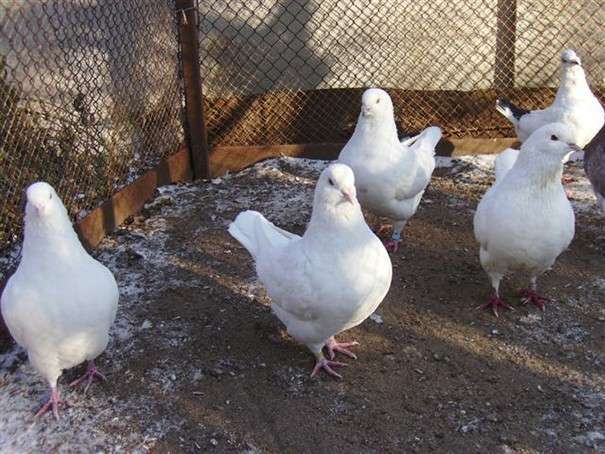Meat pigeon breed
Roman velet is one of the largest pigeon meat breeds
It turns out that since a long time ago, people have been staring at pigeons not only for express delivery of correspondence, but also viewing them under a purely gastronomic lens. The first pigeons that were to be bred were not carried around Teresa by telegram, but became carriers of tender, tasty meat, for which the species of great pigeons were most suitable. Of course, today the most popular decorative breeds of pigeons, but also meat, have not lost popularity.
Heads suitable for meat breeds of pigeons are as follows:
- speedgloss;
- fertility;
- ostentatiousness;
- agility to accelerated growth.
Variety of meat pigeon breeds
There are approximately seventy meat breeds, and only a dozen of them suggest that all overinsurance benefits can be attributed to them. Based on the photos of meat breeds of pigeons, you can mentally see three categories:
- Veletni or Veletni pigeons;
- meat;
- smokers.
Video about pigeon meat
Prismaki, important Veletsky pigeons are filthy flyers. Before them lie the following breeds:
- carnot;
- cleaver;
- king;
- Montauban;
- Monden;
- coshua;
- Roman;
- Ugric Veletensky;
- viburnum;
- Strasser;
- sottobank.
Chicken breeds of pigeons are called because of their similarity to chickens: wide, short coat, long legs, short tail. Their fertility and greatness are impressive. The following breeds are classified:
- Florentine;
- Maltese;
- Ugric;
- Vidensky;
- modenskiy
In this case, the meat breeds of pigeons are most similar to the original domestic pigeon, just a little more (average weight 650 g). This includes:
- Polish rice;
- Koburzsky lark;
- Great Canon;
- Beneshivsky blue;
- Moravian Strasser.
In Russia, especially in the Krasnodar region, they grow as large domestic pigeons, and meat pigeons - Strassers, Kings, Romans, Texans. More recently you can eat Ugric Veletensky, Maltese, Sottobanki, Polish rice, Carnot, Koburzian larks.
Strasser
 This, perhaps, is the finest meat breed. The Strassers are descended from Austrian, Czech and German ancestors. Their advantages are a great living vase, decorativeness, excellent meat quality and enviable fertility (up to 7 broods per river). The Strasser has wide, round chests, a plump body, and a long neck. Short legs without feathers, wing and tail of medium size. The tail and top of the coat are gray, black or fawn, and the bottom is white. Males weigh 600-800 g, females are lighter - 500-600 g. The speed of the strasses is good - within a month the chicks can easily reach the mature vagina. Disadvantages: bloatiness and fluffiness. The great pigeons of the Strasser breed are flying.
This, perhaps, is the finest meat breed. The Strassers are descended from Austrian, Czech and German ancestors. Their advantages are a great living vase, decorativeness, excellent meat quality and enviable fertility (up to 7 broods per river). The Strasser has wide, round chests, a plump body, and a long neck. Short legs without feathers, wing and tail of medium size. The tail and top of the coat are gray, black or fawn, and the bottom is white. Males weigh 600-800 g, females are lighter - 500-600 g. The speed of the strasses is good - within a month the chicks can easily reach the mature vagina. Disadvantages: bloatiness and fluffiness. The great pigeons of the Strasser breed are flying.
King
Pigeons of this meat breed appeared in the USA in 1890 as a result of selective breeding. They have widely spaced, long legs, deep-set chests, a large body, and a raised, shortened tail. Behind the exterior, the blue king guesses the trigger. The barley can be of different colors: black, red, gray, yellow, beige colors. White individuals are respected the most. Males weigh 800-900 g (record holders go over the kilogram), and females - 500-700 g. Young pigeons weigh as much as 650 g per month.
Texani
 Birds of this breed are particularly productive. They were captured in the middle of the last century near Texas. The age of the texan can reach 900 g. Other meat breeds of the texan are distinguished by well-developed secondary characteristics, so they can be separated immediately after their hatching from the eggs. Males have a light coat, short fluff or just a day, while females have a long yellow fluff, and there is a brown mark on the body. Especially rich pigeons of this breed are characterized by rapid growth and maturity, calm breeding and extraordinary fertility - a pair can breed up to 16 chicks.
Birds of this breed are particularly productive. They were captured in the middle of the last century near Texas. The age of the texan can reach 900 g. Other meat breeds of the texan are distinguished by well-developed secondary characteristics, so they can be separated immediately after their hatching from the eggs. Males have a light coat, short fluff or just a day, while females have a long yellow fluff, and there is a brown mark on the body. Especially rich pigeons of this breed are characterized by rapid growth and maturity, calm breeding and extraordinary fertility - a pair can breed up to 16 chicks.
Roman velet
It is completely obvious that this breed comes from Italy. In Roman velet, the plumage colors can be varied: black, chervony, polka dot-blak, white, fawn with brown overlay. These pigeons have a strong, large and thick coat, the length of the blue of the meat breed extends over half a meter to the tip of the tail. Flyers stink, which is not surprising considering their size is 1.3-1.4 kg. Because the Roman pigeons of the meat breeds are kept in place of their own in the aviary, which is no more than two meters above the ground, they need nests of the same size. These pigeons are fragile and prone to obesity, which negatively affects their fertility. The strengths of the Roman breed are that it is resistant to many diseases and is very trustworthy.
Carnot
The French bred meat pigeons of the Carnot breed at a time when birds began to live in aviaries, and pigeon breeding began to be actively mechanized. This is due to the fact that the exterior of the carno vyishov is such that it is only possible to live in the enclosure and not forage. In this meat breed, the live weight does not exceed 650 g, but it is visible from the point of view of the rate of ingestion and productivity. It is important to call this breed particularly beautiful: the breasts are so voluminous, the even small head is made visible by the disproportionate bulk of the neck. The pigeon has a long, curved horn, weakly curved wings and a short tail. The plumage can be of different colors: white, black, yellow, and the legs are thinner.
Monden
 This breed was bred in the town of Monde-Marsan (France), as a result of which it lost its name. This very decorative bird can be aged up to 1100 g, with a minimum life expectancy of 860 g. The Mondenian pigeon has a life expectancy of at least 700 g until the end of the month. 61%. They also have the highest mass index, which serves as one of the characteristics of fleshiness – 28.7%.
This breed was bred in the town of Monde-Marsan (France), as a result of which it lost its name. This very decorative bird can be aged up to 1100 g, with a minimum life expectancy of 860 g. The Mondenian pigeon has a life expectancy of at least 700 g until the end of the month. 61%. They also have the highest mass index, which serves as one of the characteristics of fleshiness – 28.7%.
Prakhensky Kanik
This ancient breed from the Czech Republic can be found in Crimea. The live weight of the male reaches 550-750 g, and the female reaches up to 600 g. The Prachensky Canik is similar to the Blue Canik, and in terms of meat characteristics it is close to the Florentine Pigeon. The Inodi breed is controversially called “buzzard”. This breed has the potential to produce a large litter, which grows rapidly.
Did you eat pigeon meat? Did you receive this chi? Tell us about the price


